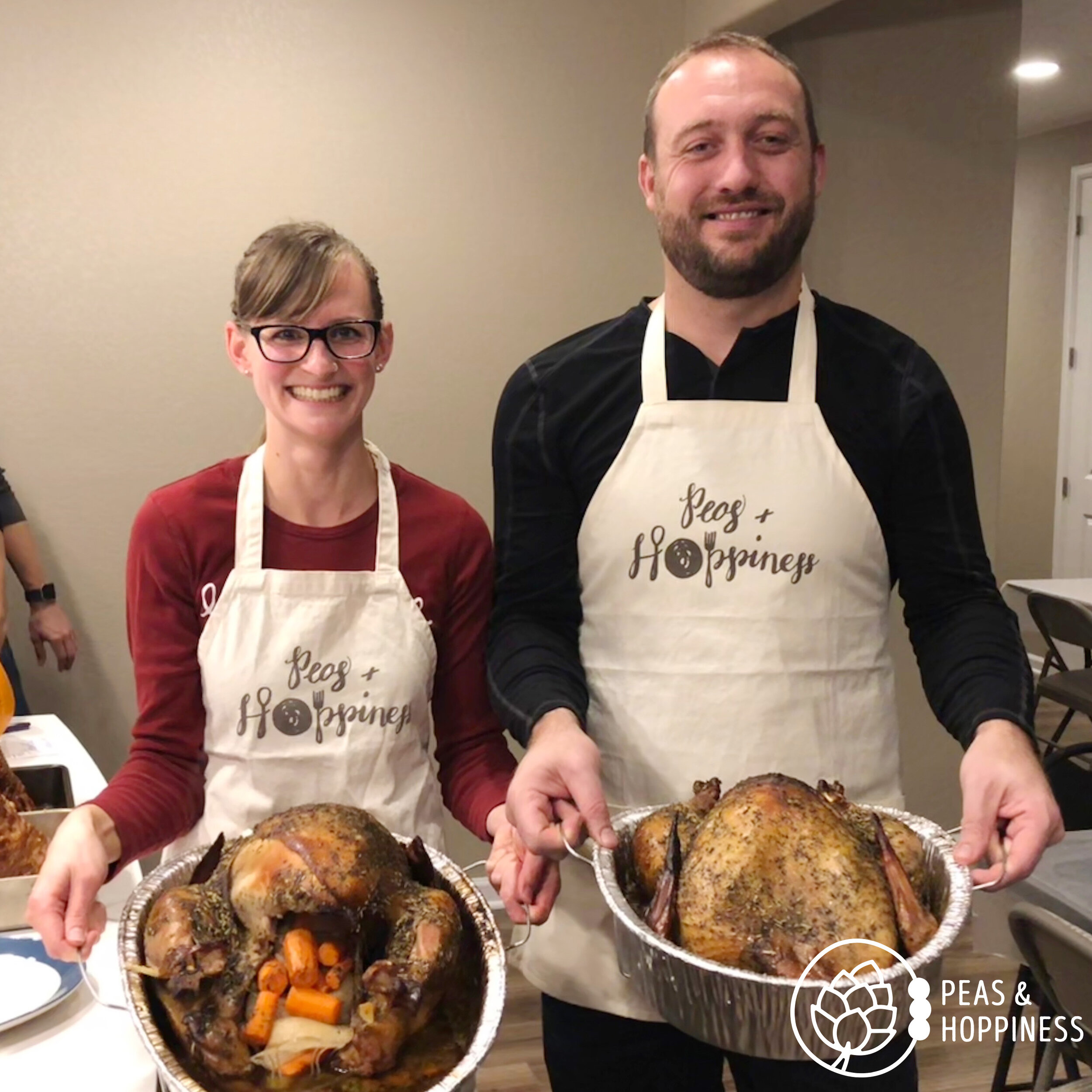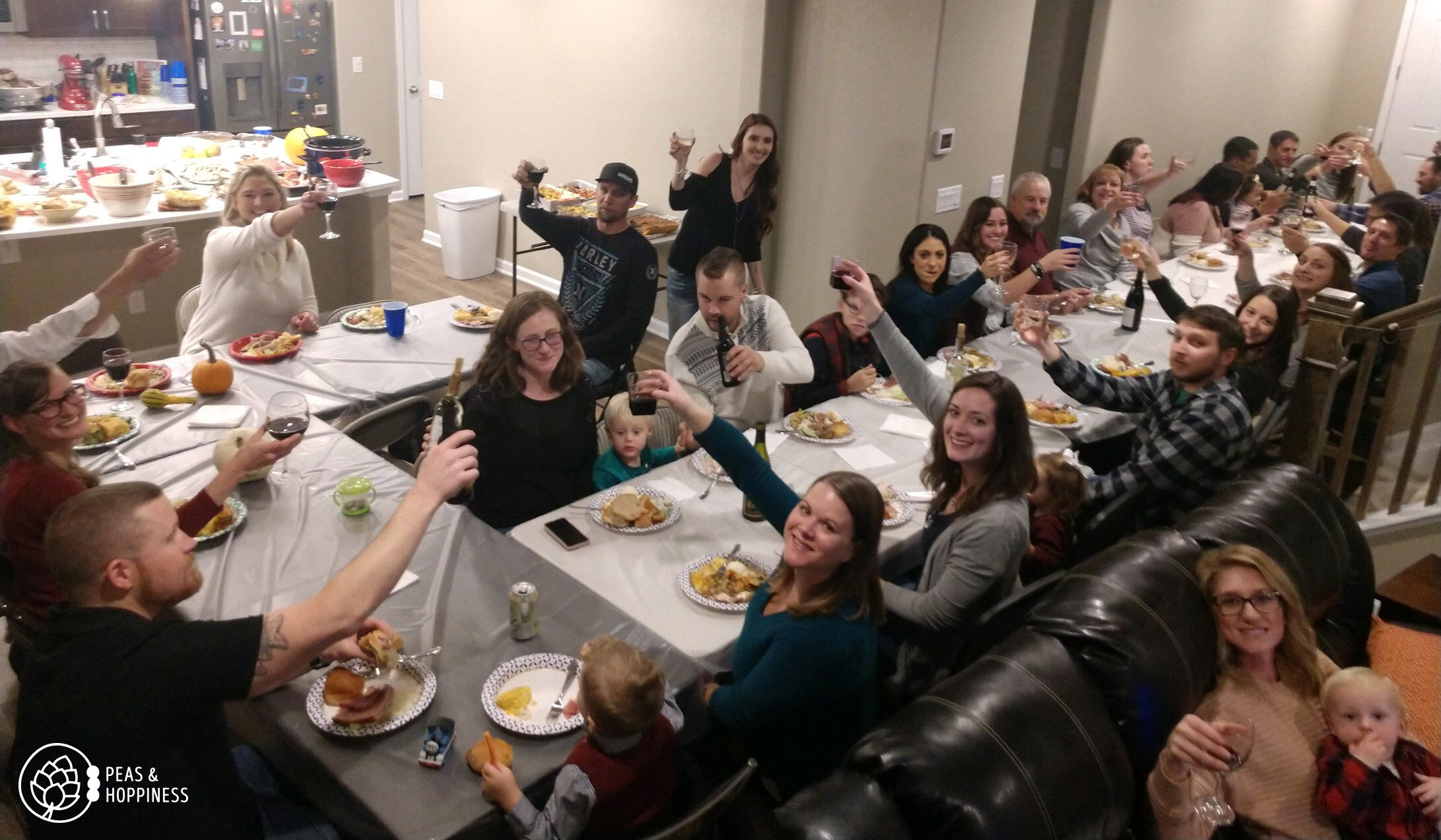
Turkeys for Friendsgiving and me with Shannon, my sous chef extraordinaire and creator of several recipes used on my meal guides and plans!
Worried about how to avoid weight gain during the holidays? Try these 5 tips to survive Thanksgiving and Christmas without needing a post-holiday diet to lose weight.
It probably comes as no surprise to you that Thanksgiving is my favorite holiday.
A holiday entirely devoted to cooking and eating delicious food with people you love? I’m in.
But for many of us, this marks the beginning of a stressful season. In addition to this time being full of festivities and cheer, it’s also filled with sweet treats, baked goods, and favorite foods we often only enjoy during this time of year.
How can you enjoy all of the yummy goodies without feeling out of control?
If you’ve been asking yourself this question, you’re not alone. While this is by no means an all-inclusive list, try starting with these 5 tips to explore the balance of soul food and fuel food this season:
Tip #1: Plan Ahead
It might not be the most glamorous, but going into the holidays with a meal plan can save you so much stress in multiple ways.
If you’re hosting family or friends, writing down the schedule and how many people will be in attendance can help you make sure to have enough food, reduce the amount of overbuying (which is easy to do), and help you manage your leftovers so food doesn’t spoil in your fridge.
Planning ahead can also help you make sure you have plenty of fruits and veggies on hand, as well as options to cook these to make them enjoyable.
It’s certainly okay (and important!!) to enjoy favorite foods at the holidays, but you’ll likely enjoy them even more when you balance out your meals with nutrient-dense foods to keep you full and satisfied.
Download this meal planning template to help you organize your schedule, the number of eaters, your leftovers, cooked meals, and breakfast/lunch/snack options.
Tip #2: Mindfully Enjoy Favorite Foods
As a registered dietitian nutritionist, I truly believe all foods fit into a healthy eating pattern.
Yes, this includes fudge. And apple cider. And homemade Chex mix.
If you’ve had the (very common) experience of restricting any of these foods – perhaps you’ve been on a diet or sometime in your life you were shamed for eating them – these foods can become triggers for overeating. It takes time to fully make peace with food and learn how to navigate previously restricted foods without going overboard; don’t expect this to change during one holiday season.

My childhood tradition: picking our our Charlie Brown Christmas tree from the pasture in the Sandhills
As you navigate your favorite foods this year, consider focusing on these two mindfulness practices:
-
Focus on savoring your favorite foods: notice the flavor, texture, temperature, and other qualities of the food you’re eating. What makes it taste good? Is that vanilla you detect? Is it cinnamon or nutmeg flavoring the dish?
-
Tune into your hunger cues: worried about how MUCH you “should” be eating? Your body has the answer! Instead of counting calories this season, which can take so much joy out of eating, notice how your body feels before and after eating. If this is a challenge, try inserting a “pause” into your snacking: for example Instead of digging into the communal caramel corn bowl, find an individual bowl or plate and serve yourself some. Once your bowl is finished, give yourself permission to go back for more – but first notice if you’re still enjoying eating this food, what your fullness level is, and if you’d rather eat something else. Portioning your food can give you time to be thoughtful. And if the answer is, “Yes! I want more!” then you have full permission (from yourself) to enjoy another serving!
If you want to explore this further, take a look at my nutrition coaching services where I go in depth with clients to help them heal their relationship with food.
Tip #3: Continue to Fuel your Body
Continuing to eat regular meals and snacks, complete with protein + veggies + quality carbs can help you avoid that overly-hungry binge eating which is easy to do when you’re starving.
In fact, overeating after fasting for too long is actually a normal response from your body; it’s trying to save you from the famine (whether it’s real or self-imposed and whether you like it or not).
Often the desire to skip meals in order to save room for other goodies comes from “Last Supper Thinking.” This is the feeling that the options in front of you will only be available for a short time and then you’ll have to drastically change your eating pattern to exclude these again.
To help with this, consider incorporating some of these foods into the days before and after your big event. Perhaps enjoy the cookies as part of other meals – or maybe even consider making them at another time during the year to reduce the scarcity that comes with holidays.
My favorite personal example of this is our tradition of eating pie for breakfast the day after Thanksgiving. It’s delicious!

A glimpse into my childhood: building a snowman with brother Ray, Mom, and Aunt Sue
Tip #4: Stay Active
With cooler temperatures and a busy schedule, it’s easy to leave exercise off your to-do list. But connecting with your body in ways outside of food is so important for your mental and physical health!
If you’re bored of your usual routine – or just want to have some holiday fun – consider trying other types of movement during the holidays. Here are a few of my favorite examples of mindful movement which doesn’t include going to the gym:
-
Snowball fight with the nieces and nephews
-
Dance party in the kitchen to favorite holiday tunes
-
Walk through the holiday lights after dinner
-
Yoga video with the family (hilarious to get the kids to join if they haven’t done yoga before)
Your movement shouldn’t feel like punishment for the food you ate; rather, the goal is to find joy in moving your body.
Tip #5: Relax and Enjoy!
The holidays only come around once per year; it’s okay to enjoy them!
The key is to be fully present as you enjoy your favorite foods and favorite people. Savory the peppermint bark, notice the taste and texture of the mashed potatoes, and bask in the crunch of the chocolate-covered pretzels.
This time of year isn’t about having a “perfect” diet (actually, it really is NEVER about perfection). Instead of stressing about how many cookies you’re eating, make sure you’re enjoying the quality of each one.

Friendsgiving 2018, in which we somehow fit over 40 people in our house and
And when you’re ready to get back to your “normal” eating, use your meal planning template to help you include lots of yummy, nutrient-dense foods, get back to your cooking routine, and make a plan for the grocery store.
These tips might feel much easier said than done. If you want to talk about your specific nutrition goals and challenges, consider scheduling a complimentary discovery call to learn how individual nutrition coaching could help you bridge the gap between where you are with your relationship with food and where you want to be.
I hope you enjoy all the wonderful warm and fuzzy feelings of the holidays, of your family, and of your favorite foods.
Happy holidays,
Ann from Peas and Hoppiness